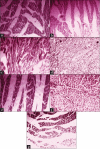Role of Mitochondrial Enzymes and Sarcoplasmic ATPase in Cardioprotection Mediated by Aqueous Extract of Desmodium gangeticum (L) DC Root on Ischemic Reperfusion Injury
- PMID: 21969747
- PMCID: PMC3178976
- DOI: 10.4103/0250-474X.84585
Role of Mitochondrial Enzymes and Sarcoplasmic ATPase in Cardioprotection Mediated by Aqueous Extract of Desmodium gangeticum (L) DC Root on Ischemic Reperfusion Injury
Abstract
The present study investigate the protective effect of aqueous root extract of Desmodium gangeticum in preserving mitochondrial and sarcoplasmic ATPase during ischemia reperfusion injury. The isolated rat hearts in both drug and control group were subjected to warm ischemia (37°), followed by reperfusion with the Langendorff perfusion system. The aqueous root extract of Desmodium gangeticum (L) at a dose of 50 mg/kg body weight was found to be effective in the rat heart for the management of ischemic reperfusion injury. Physiological parameters were significantly (P<0.05) improved in drug treated rat hearts. Creatine phosphokinase in coronary perfusate found to be declined. Moreover, sarcoplasmic ATPase and mitochondrial enzymes were significantly (P<0.05) improved in drug treated rat hearts. In fact, histological analysis of the myocardium also suggested an improved ultra structure in Desmodium gangeticum treated rat heart. These results suggest that Desmodium gangeticum aqueous root extract can preserve the mitochondrial and sarcoplasmic ATPase in the myocardium, resulting in the improvement of cardiac function after ischemia reperfusion injury.
Keywords: Desmodium gangeticum; ischemia; mitochondrial enzymes; reperfusion; sarcoplasmic ATPase.
Figures


Similar articles
-
Antioxidant effects of ethyl acetate extract of Desmodium gangeticum root on myocardial ischemia reperfusion injury in rat hearts.Chin Med. 2010 Jan 22;5:3. doi: 10.1186/1749-8546-5-3. Chin Med. 2010. PMID: 20180993 Free PMC article.
-
Administration of aqueous extract of Desmodium gangeticum (L) root protects rat heart against ischemic reperfusion injury induced oxidative stress.Indian J Exp Biol. 2009 Feb;47(2):129-35. Indian J Exp Biol. 2009. PMID: 19374168
-
An ethnomedicinal, phytochemical and pharmacological profile of Desmodium gangeticum (L.) DC. and Desmodium adscendens (Sw.) DC.J Ethnopharmacol. 2011 Jun 22;136(2):283-96. doi: 10.1016/j.jep.2011.04.031. Epub 2011 Apr 20. J Ethnopharmacol. 2011. PMID: 21530632 Review.
-
Methanol extract of Desmodium gangeticum DC root mimetic post-conditioning effect in isolated perfused rat heart by stimulating muscarinic receptors.Asian Pac J Trop Med. 2012 Jun;5(6):448-54. doi: 10.1016/S1995-7645(12)60076-5. Asian Pac J Trop Med. 2012. PMID: 22575976
-
A brief review on chemoprofling and pharmacological potential of Desmodium gangeticum (L.) DC.Nat Prod Res. 2025 Jan 26:1-17. doi: 10.1080/14786419.2025.2455458. Online ahead of print. Nat Prod Res. 2025. PMID: 39865705 Review.
Cited by
-
Antioxidants Protect against Arsenic Induced Mitochondrial Cardio-Toxicity.Toxics. 2017 Dec 5;5(4):38. doi: 10.3390/toxics5040038. Toxics. 2017. PMID: 29206204 Free PMC article. Review.
-
Effect of trapidil in myocardial ischemia-reperfusion injury in rabbit.Indian J Pharmacol. 2014 Mar-Apr;46(2):207-10. doi: 10.4103/0253-7613.129320. Indian J Pharmacol. 2014. PMID: 24741195 Free PMC article.
References
-
- Park JL, Lucchesi BR. Mechanisms of myocardial reperfusion injury. Ann Thorac Surg. 1999;68:1905–12. - PubMed
-
- Garlickm PB, Davies MJ, Hearse DJ, Slater TF. Direct detection of free radicals in the reperfused rat heart using electron spin resonance spectroscopy. Cardiovas Res. 1987;61:757–60. - PubMed
-
- Dhalla NS, Elmoselhi AB, Hata T, Makino N. Status of myocardial antioxidants in ischemia-reperfusion injury. Cardiovas Res. 1995;47:446–56. - PubMed
-
- Becker LB, Vanden Hoek TL, Shao ZH, Li CQ, Schumacker PT. Generation of superoxide in cardiomyocytes during ischemia before reperfusion. Am J Physiol. 1999;277:H2240–6. - PubMed
-
- Dhalla NS, Temsah RM, Netticadan T. Role of oxidative stress in cardiovascular diseases. J Hypertens. 2000;18:655–73. - PubMed
LinkOut - more resources
Full Text Sources
